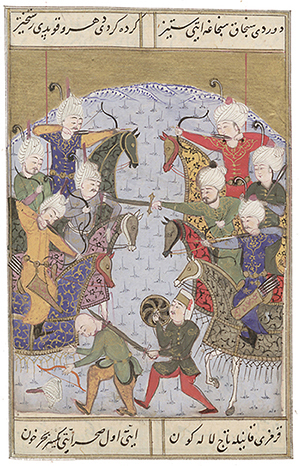
Selimname, Topkapı Palace Museum Library
A late-sixteenth-century depiction of Sultan Selim I at war.
View full image
When you think about the early 1500s, you might think about Spanish and Portuguese exploration and the beginnings of the Protestant Reformation. But if you were alive at the time, even in Europe, you’d likely have been much more interested in the rapid expansion of the Ottoman Empire. As Yale history professor Alan Mikhail argues in a new book, the success of the Ottomans made far more of an impact on Europe and the New World than most people understand.
In God’s Shadow: Sultan Selim, His Ottoman Empire, and the Making of the Modern World (Liveright), Mikhail traces the career of Sultan Selim I, who led the empire from 1512 to 1520. In that time, he nearly tripled its size, adding the Mamluk Empire based in Egypt to the territories he had inherited in Anatolia and Eastern Europe, giving him control of the Islamic holy sites of Mecca, Medina, and Jerusalem. Selim also strengthened the empire’s control of trade routes to Asia.
Enter Christopher Columbus. “To fully understand 1492,” says Mikhail, “you have to understand the Ottomans, one of the greatest geopolitical forces in the world at the time.”
Mikhail demonstrates that Columbus’s expedition was “a desperate act in desperate circumstances,” driven by the Muslim trade monopoly. He also shows that the Genoese navigator, a veteran of the wars against Islam, saw his trip as a continuation of those conflicts. Columbus planned to sail west to Asia and find the quasi-mythical Grand Khan of the East—who was believed to be sympathetic to Christianity—and enlist him in a war to defeat Islam and retake Jerusalem. (Columbus died in 1506 still believing he had sailed to Asia.)
Mikhail says that the Ottomans’ central role in the Spanish world view also influenced how the conquistadors reacted to the inhabitants of the New World. “These conquistadors were shaped by their wars with Islam,” he says. “Their understanding of an enemy was a Muslim. When they encounter indigenous peoples, they fall back on that understanding. Cortez writes that there are 400 mosques in Mexico, and he calls Montezuma a sultan.”
Mikhail also draws connections between the Ottoman threat to Europe and the Protestant Reformation. Martin Luther wrote extensively about Islam, and although he saw the faith and its practitioners as evil, he found things to admire in their practice—such as prohibiting religious images and rejecting ecclesiastical hierarchy. Furthermore, says Mikhail, “the Catholic powers were very worried about the Ottomans,” and the time and energy they put toward those worries “afforded Luther a little bit of breathing room.”
The book also includes provocative speculation about what might have been. Selim died in 1520 at only 49 years old, perhaps of plague. In his last years, he was working on a plan to invade Morocco, which would have given the Ottomans a base on the Atlantic. Just a few months before he died, Selim was presented with a map of the world. Fascinated, he pored over the document, then asked a secretary to replace all the Latin and Italian place names with Turkish ones: Hispaniola in the Caribbean, for example, became Vilayet Antilia.
To Mikhail, Selim’s meaning is clear: “He intended to make the whole world Ottoman.”
 loading
loading